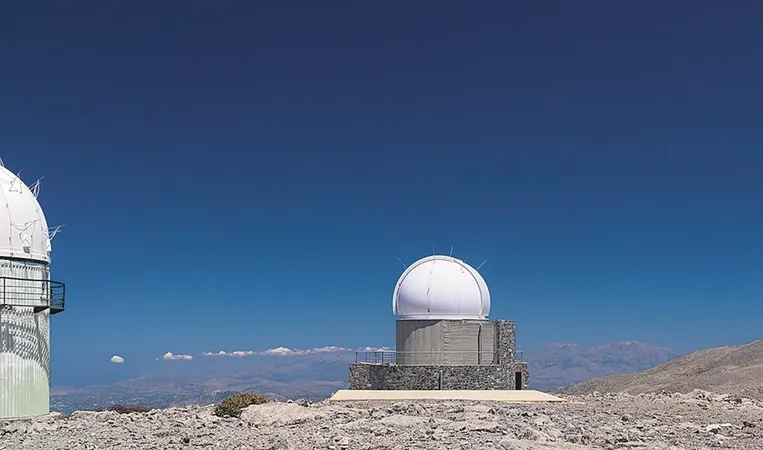
Discovering the Cosmos: A Journey to the Skinakas Observatory on Mount Psiloritis
2024-09-28
Author: Li
As we embark on our adventure from the picturesque village of Anogeia in central Crete, the car thermometer gracefully dips from a sweltering 30 degrees Celsius, dropping 10 degrees as we ascend the majestic Mount Psiloritis, also known as Ida. The landscape around us transforms dramatically; the lush greenery gives way to bare rocky outcrops, with herds of goats and black rams with striking twisted horns grazing peacefully along the mountainside.
Our destination, the Skinakas Observatory, comes into view through the cool mountain air. Dr. Vassilis Charmandaris, an esteemed professor of physics at the University of Crete and the observatory's director, greets us warmly, clad in a jacket emblazoned with the Skinakas logo. The chill is palpable as we step out; while the thermometer reads 19 degrees Celsius, the biting wind makes it feel closer to -1. Standing at 1,750 meters above sea level, we gaze out to the north to see the stunning coastlines of Crete, while to the south lies the shimmering Libyan Sea. The setting sun bathes the horizon in fiery hues, and as the first stars begin to twinkle, my curiosity is drawn towards the birds gliding effortlessly overhead. “Eagles?” I inquire. “No, vultures,” Charmandaris corrects with a smile.
The Inception of Skinakas Observatory
The inception of the Skinakas Observatory dates back to the summer of 1984. In a groundbreaking collaboration between the University of Crete, the Foundation for Research and Technology - Hellas (FORTH), and Germany's illustrious Max Planck Institute for Extraterrestrial Physics (MPE), the observatory was designed to educate aspiring astronomers and advance research on celestial phenomena, including comets and nebulae. Pioneering professors Ioannis Papamastorakis and Gerhard Haerendel were instrumental in bringing this vision to life.
"What was envisioned by the observatory's founders was ambitious yet straightforward: to establish a modern observatory in Greece that trains students in contemporary astronomical exploration while serving as a cutting-edge research facility attracting prominent scientists from around the globe," Charmandaris shared during our visit.
Halley's Comet and the Grand Opening
The timing was fortuitous; Halley's Comet was set to pass through our skies in spring 1986, an astronomical event that hadn’t graced our planet since 1910. In a stunning display of determination, just 16 months after receiving a donation from Anogeia Municipality, the observatory’s road was paved and the building for the first telescope was completed. The grand opening on April 12, 1986, drew an eager crowd who witnessed the first-ever digital photograph of Halley's Comet, taken using Greece’s inaugural digital camera attached to a 30 cm telescope.
Advancements and Contributions
By 1988, a guesthouse had been constructed that quickly hosted Greece’s first school of Observational Astrophysics. A more sophisticated 1.3-meter telescope was commissioned in 1995, followed by a revolutionary 0.6-meter fully robotic telescope installed in 2006 through a partnership with the University of Tübingen. This state-of-the-art instrument allows amateur astronomers to participate in the excitement of astrophysics remotely.
“This trio of telescopes has trained numerous undergraduate and graduate students from Greece and abroad, contributing to about 300 published papers—almost double the amount from all other Greek observatories combined,” Charmandaris noted proudly.
The Future of the Observatory
In 2018, the establishment of the Institute of Astrophysics at FORTH endowed the Skinakas Observatory with renewed vigor and adaptability. Anticipation grows as two new telescopes, including a 1-meter mirror funded by the Greece 2021 Committee, are expected to join the observatory by 2025. Additionally, through collaboration with researchers in the United States, 16 small telescopes will come into operation, aiming for a groundbreaking capability to capture images of any celestial point within two seconds. "These advancements will allow us to observe supernova explosions and pinpoint sources of gravitational waves," he explained.
Educational Outreach and Community Engagement
Our exploration of the observatory continues, leading us to encounter Dr. Efthymios Palaiologou, a dedicated retired telescope support scientist. Despite his retirement, he continues to engage deeply with the celestial phenomena displayed on the multitude of screens before him. Accompanied by eager physics students volunteering at the observatory, the atmosphere is electric. “Keep the lights off,” he advises, as the dome opens, revealing a captivating constellation of stars overhead.
Significance in Space Data Reception
The observatory’s significance extends beyond just education and research; it has been selected by the European Space Agency to act as a key terminal for receiving data from space. “With the costs of launching satellites decreasing rapidly and the number already exceeding 9,000, our strategic location in Crete positions us favorably for this crucial role,” Charmandaris remarked. The observatory will also assist in observing low-orbiting satellites swiftly traversing the sky.
Technological and Economic Implications
The collaboration between Crete’s academic ecosystem and its expert researchers will not only propel forward significant technological advancements but also pave the way for economic opportunities reminiscent of the region's journey with the first Internet spin-off, FORTHnet, 35 years ago.
A Night Under the Stars
As we wrap up our visit, we journey back to Anogeia to attend the annual meeting of the Crete Association of Friends of Astronomy. Under a canopy of stars, we observe a group of enthusiastic young astronomers marveling through telescopes, their eyes wide with wonder as they spot the moon and a shooting star. The joy is palpable, igniting curiosity for generations to come. As I gaze upwards, pondering what the Skinakas Observatory will unveil to the world in 2062 during the next appearance of Halley’s Comet, I contemplate the vastness of the universe and the unending pursuit of knowledge that lies ahead.
Prepare for an adventure beyond imagination and the mysteries waiting to be unveiled at the Skinakas Observatory!




 Brasil (PT)
Brasil (PT)
 Canada (EN)
Canada (EN)
 Chile (ES)
Chile (ES)
 Česko (CS)
Česko (CS)
 대한민국 (KO)
대한민국 (KO)
 España (ES)
España (ES)
 France (FR)
France (FR)
 Hong Kong (EN)
Hong Kong (EN)
 Italia (IT)
Italia (IT)
 日本 (JA)
日本 (JA)
 Magyarország (HU)
Magyarország (HU)
 Norge (NO)
Norge (NO)
 Polska (PL)
Polska (PL)
 Schweiz (DE)
Schweiz (DE)
 Singapore (EN)
Singapore (EN)
 Sverige (SV)
Sverige (SV)
 Suomi (FI)
Suomi (FI)
 Türkiye (TR)
Türkiye (TR)
 الإمارات العربية المتحدة (AR)
الإمارات العربية المتحدة (AR)